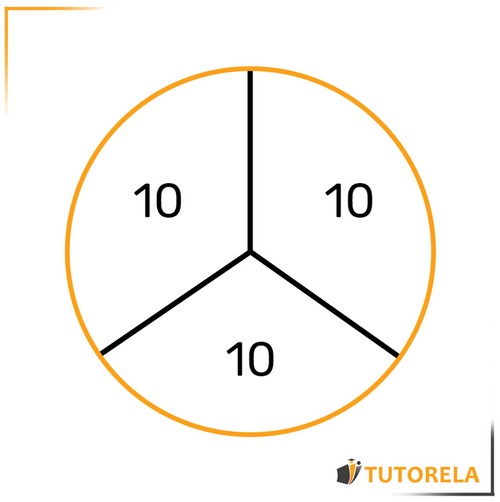We will divide the total amount by the denominator of the part, multiply the result obtained by the numerator of the part and obtain the partial amount.
Part of a quantity
To find the partial amount
To find the total amount
We will divide the given number (part of a quantity) by the numerator of the part.
We will multiply the result by the denominator of the part and obtain the whole quantity.
To find the part of the quantity
In the numerator - we will note the partial amount
In the denominator - we will note the total amount
We will reduce the fraction we receive and reach the desired part.
Test yourself on part of an amount!
What is the marked part?
Part of a quantity
The topic of a part of a quantity in fractions is pleasant and easy if you understand the principle and logic.
Therefore, focus and see how you learn to solve questions about a part of a quantity without any problem.
In everyday life, a whole quantity can be the number of children in a class for example, and a part of a quantity is the number of children studying in a specific class.
We divide the topic into 3 situations.
The first situation: finding the amount of a part
The total amount is known
and we want to know something specific about a part of the amount.
Procedure:
We will divide the total amount by the denominator of the part.
We will multiply the result obtained by the numerator of the part and we will get the final answer.
Let's see this while asking a question:
In the music class there are students - this is the total amount.
Of the class plays the guitar - that is the specific part.
How many children in the music class play the guitar? – the part of the total amount.
Solution:
to know how much is
We will divide the total amount -> by the number (The number that appears in the denominator of the part.
We will get:
If we multiply by the numerator of the part -> we still get, .
That is of is children.
We can also see this in the illustration:

When we divide by into equal parts, we get that each part is equal to .
This means that-> children in the class play the guitar.
Bonus section:
of the music class play the drums.
How many children play the drums?
Solution:
Now we want to know how much is of
We found out that of is children and therefore of is children. That is children play the drums.
The main way without depending on the first section:
We will divide the total amount - By the denominator of the part ->
We get
The result we got, we multiply by the numerator of the part ->
We get
Answer:
That is children play the drums.
What is the marked part?
What is the marked part?
What fraction does the part shaded in red represent?
Now we will move on to the second situation: finding the total amount.
The total amount is unknown
A part of an amount is known and given in a number (it is called partial amount).
The procedure is:
we will divide the given number (partial amount) by the numerator of the part.
We will multiply the result by the denominator of the part and obtain the total amount.
Let's look at this while we ask a question
students in the class wear a red shirt and make up of the class.
How many children are in the class?
Solution:
here we need to find the total amount, so we will solve it according to the previous steps.
We will divide the given number (the partial amount) –> by the numerator of the fraction and we get:
The result we obtained we multiply by the denominator of the fraction - and we will get the total amount.
We get:
Answer:
There are students in total in the class.
What is the marked part?
What is the marked part?
What is the marked part?
Now we will move on to the third (and easiest) situation: finding the part of the quantity
The total amount is known
The partial amount (the given number) is known
The part in the fraction is unknown
The procedure is:
We will divide the partial amount by the total amount - using a fraction.
That is:
In the numerator - we will note the partial amount
In the denominator - we will note the total amount
The fraction we obtained, we will reduce and obtain the desired part.
Let's exercise
children in the class can speak English.
There are a total of children in the class.
What part of the class can speak English?
Solution:
We will write the partial amount in the numerator
and in the denominator we will write the total amount
We obtain:
We reduce and obtain:
Answer:
of the students in the class can speak English.
Examples and exercises with solutions of part of a quantity
Exercise #1
What is the marked part?
Video Solution
Step-by-Step Solution
To solve this problem, we will count the total number of equal sections in the grid and the number of these sections that the marked area covers.
- Step 1: Determine Total Sections. The grid is divided into several vertical sections. By examining the grid lines, we see that the total number of vertical sections is 7.
- Step 2: Determine Marked Sections. The marked (colored) part spans 3 of these vertical sections within the total grid.
- Step 3: Compute Fraction. The fraction of the total area covered by the marked part is calculated as the number of marked sections divided by the total number of sections: .
Therefore, the fraction of the area that is marked is .
Answer
Exercise #2
What is the marked part?
Video Solution
Step-by-Step Solution
To determine the marked part, we need to calculate the fraction of the diagram that is shaded red.
First, we count the total number of rectangles in the diagram. There are 10 rectangles visible along a straight line.
Next, we count the number of rectangles shaded red. There are 8 red rectangles in the diagram.
Therefore, the fraction of the total diagram that is marked red is calculated as .
This fraction simplifies to , but the answer provided is in the form , which is equivalent.
Therefore, the marked part of the diagram is .
Answer
Exercise #3
What fraction does the part shaded in red represent?
Video Solution
Step-by-Step Solution
To work out what the marked part is, we need to count how many coloured squares there are compared to how many squares there are in total.
If we count the coloured squares, we see that there are four such squares.
If we count all the squares, we see that there are seven in all.
Therefore, 4/7 of the squares are shaded in red.
Answer
Exercise #4
What is the marked part?
Video Solution
Step-by-Step Solution
To solve the problem of finding the fraction of the marked part in the grid:
The grid consists of a series of squares, each of equal size. The task is to count how many squares are marked compared to the entire grid.
- First, count the total number of squares in the entire grid.
- Next, count the number of marked (colored) squares.
- Then, calculate the fraction of the marked part by dividing the number of marked squares by the total number of squares.
Let's perform these steps:
The grid displays several rows of columns. Visually, there appear to be a total of 10 squares in one row with corresponding columns, forming a grid.
Count the marked squares from the provided SVG graphic:
- There are 4 shaded (marked) regions.
Total squares: 10 (lines are shown for organizing squares, as seen).
Calculate the fraction:
Thus, the marked part of the shape can be given as a fraction: .
Answer
Exercise #5
What is the marked part?
Video Solution
Step-by-Step Solution
Let's solve this problem step-by-step:
First, examine the grid and count the total number of sections. Observing the grid, there is a total of 6 columns, each representing equal-sized portions along the grid, as evidenced by vertical lines.
Next, count how many of these sections are colored. The entire portion from the first column to the fourth column is colored. This means we have 4 out of 6 sections that are marked red.
We can then express the colored area as a fraction: .
Answer
What is the marked part?
What is the marked part?
Which figure shows a shape with\( \frac{1}{3} \) of its area shaded in red?
More Questions
Part of an Amount
- The Order of Basic Operations: Addition, Subtraction, and Multiplication
- Order of Operations: Exponents
- Order of Operations: Roots
- Division and Fraction Bars (Vinculum)
- The Numbers 0 and 1 in Operations
- Neutral Element (Identity Element)
- Order of Operations with Parentheses
- Order or Hierarchy of Operations with Fractions
- Opposite numbers
- Elimination of Parentheses in Real Numbers
- Addition and Subtraction of Real Numbers
- Multiplication and Division of Real Numbers
- Multiplicative Inverse
- Integer powering
- Positive and negative numbers and zero
- Real line or Numerical line
- Fractions
- A fraction as a divisor
- How do you simplify fractions?
- Simplification and Expansion of Simple Fractions
- Common denominator
- Hundredths and Thousandths
- Sum of Fractions
- Subtraction of Fractions
- Multiplication of Fractions
- Division of Fractions
- Comparing Fractions
- Placing Fractions on the Number Line
- Numerator
- Denominator
- Decimal Fractions
- What is a Decimal Number?
- Reducing and Expanding Decimal Numbers
- Addition and Subtraction of Decimal Numbers
- Comparison of Decimal Numbers
- Converting Decimals to Fractions
- Remainder of a fraction
- Decimal fraction remainder
- Remainders
- Order of Operations - Exponents and Roots
- Special cases (0 and 1, reciprocals, fraction line)









